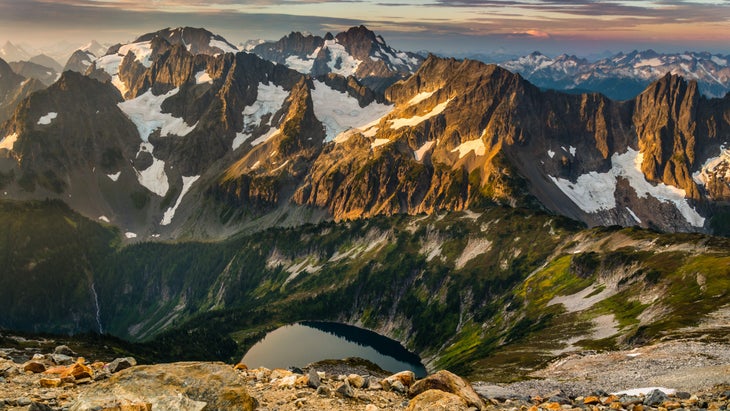



When it comes to new year’s resolutions, there are two kinds of people in this world. There are the optimists, who set big goals and commit themselves to the hard work of achieving them. Then there are the cynics and skeptics who have accepted that their bad habits are theirs, and that flipping a page on the calendar won’t change that.
This year, our staff is taking a page from the latter by learning to love our on-trail quirks. We asked our editors to share the bad habits that they have no plans to change in 2024. From tricking their kids into going hiking to stressing about parking when we should be paying attention to the trail, here’s what they said.
Years ago, I met a retired trekking guide who had gotten so used to reading herself to sleep by headlamp that she even did it in her bed at home. I always thought that sounded like a beautiful routine: Hike the world all day, then let your mind go on another adventure somewhere far away before slipping off for the night. Unfortunately, after years of trying, I’m starting to realize I’m just not a tent reader.
Here’s how it usually goes. I snuggle into my sleeping bag, prop my head up on a stuffsack of extra layers, and crack open whatever paperback I’ve brought. Smash cut to eight hours later: I wake up to the first rays of the sun filtering under the book, which is spread over my face like an impromptu sleeping mask and moist with condensation, drool, or both. I’ve tried reading under the stars (too cold) and reading during breaks (not long enough). At this point a smarter hiker would probably just ditch the dead weight. Every trip, though, I keep hoping this will be the one where it clicks and I actually make it through at least a couple of chapters. But deep down, I know that I’m just taking my library for a walk. –Adam Roy, Executive Editor
Like many hikers, I’ve often sought out solitude in the backcountry. Few things beat having an entire lake basin to yourself at sunset, or the complete quiet of a forest devoid of other people. But last summer, instead of avoiding hordes of hikers, I joined them. It was my first hiking season in a new state, so instead of getting off the beaten path, I stayed on it, ticking off all of the classic and most popular hikes in my area. Turns out, they’re popular for a reason.
On my hike up Cascade Pass and the Sahale Arm in North Cascades National Park, I passed hundreds of other people—but with endless mountain views, there was room enough for all of us. That day, I also hiked by baby mountain goats, and found a quiet (enough) spot to eat my lunch and marvel at the glaciated peaks around me. While hiking solo, it can also be comforting to know other people are around in case something goes wrong. There will be plenty of time to explore the seldom-visited corners of my local woods and mountains. But for now, I want to see what all the fuss is about. —Zoe Gates, Senior Editor

My son is 4 years old, which is an awkward age when it comes to taking him hiking. He’s too big for me to carry long distances, but too easily distracted to walk very far under his own power. For a while, I turned to that classic parent tactic: bribery–sure, you can have an M&M, as soon as you walk up this hill. But lately, I’ve seen diminishing returns as he’s figured out he can just dig in his heels and demand bigger and bigger payouts for less and less effort. So I’ve had to get more creative with the truth.
On a dayhike late last year, I hid a gummy worm under a shrub when he wasn’t looking, then “discovered” it. When he asked for another, I told him that I couldn’t find any more, but that I seemed to remember another nest of them about a quarter-mile down the trail. I milked that story through a three-hour hike, my kid searching for gummy worm “burrows” at every break. It kept him engaged and engrossed in the hike, and he never once complained or asked to go home and watch cartoons. Will it teach him that hiking is a chore you do for a reward, rather than an end in itself? I’ll worry about that when I’m not trying to coax him through a 2-mile hike before the sun goes down. And while I would never tell you to be dishonest with your hiking partners, I’ll note that this tactic works pretty well with adults too. Yeah, sure, we’re gonna hit a great view soon. We just have to climb this talus slope first. –A.R.
It’s one of the worst feelings to wake up before the sun on the weekend, drive a couple hours into the mountains for a dayhike, and end up stonewalled by a full trailhead parking lot. I’ve encountered this time and time again, but the worst occurrence was in Great Smoky Mountains National Park several summers ago for a dayhike. We had a late start in the morning, so we made it to the park entrance by early afternoon, setting us up for parking failure. On the drive there, I was calculating how many cars would probably be passing through the country’s most visited national park during the most popular season. Sure enough, we arrived at a completely full trailhead lot. I felt that pit in my stomach form as we (maybe unethically?) parked in an undesignated area. We were only hiking for a couple of hours, but instead of taking in the views of the misty rolling peaks in the distance, I was picturing our car getting ticketed or towed.
I’ve more strategic about finding parking, but I stress about it all the same. On the nights before a trip, I compulsively read comments on trail guides, hiking blogs and YouTube to map out when we need to leave to guarantee a parking spot. I’m more worried about encountering full parking lots than encountering bears. When I’m hiking, I want my mind to meditate in nature uninterrupted. Some might call my tendency to worry about trailhead parking a bad habit, but I call it a successful preparation tactic. — Emma Veidt, Assistant Editor
From 2024

